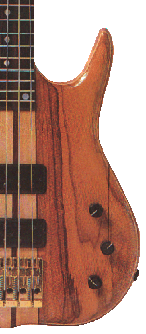
Making Your First Guitar
A Tutorial
Tools
You've probably heard the axiom, You need the right tools for the job. A full range of power tools makes life a little easier and perhaps a bit more accurate, but if you are determined to build an instrument, it can be done without them. Much can be accomplished by hand tools, basic power tools, as well as, what can be found in the community. If you can find room within your budget, you might invest in some basic power tools such as a jig saw, a router and a belt or orbital sander. You might consider checking to see if the local Rent-All store has any of the power tools you require. Here, for a price, you can borrow what you may need. Approach a local high school about using their shop tools after hours.
Your wood supplier or local lumber yard will usually be willing to cut stock to size and, as they usually have band saws for re-sawing and planers or thickness sanders, you may be able to talk them into doing some additional work that you might require. Use your imagination to either gain access to the particular tool you need, or to find an alternative way to do what is required.
A variety of tools that make the job easier are listed below:
Band Saw
For "resawing" lumber to the proper tickness, "book matching" overlays, and just cutting out the outline of the instrument. A jig saw can be used to cut out the shape as an alternative.
Planer
To surface the wood and make sure it is even and flat along its length or to take a blank for a body down to its required thickness. This is particularly useful when laminating a neck or putting an exotic wood overlay onto a core to make a laminated body. You might try hand planing, but my accuracy and patience are not sufficient to ever finish the job by hand.
Jointer
Somewhat akin to a small planer, used to square up one side of a piece of lumber. You can probably get away with using a jointer for many of the procedures you would use the planer for in this construction. The planer and jointer are much more important when making a neck and/or body by laminating various pieces of wood together.
The accuracy of these tools makes for a very flat and even surface which, in turn, makes the seams virtually invisible. If you carve your body or neck from a solid piece of stock, you usually can get around having to use these tools. The most critical area in terms of flatness would be the portion of the neck where the fingerboard will be attached.
Drill Press
Used with drills or Forstner bits to drill holes for the tuning pegs or to remove larger amounts of material from pickup cavities, etc. Careful work with an electric or manual hand drill can accomplish the same work and if you have a router, the pickup cavities can be cut out using it with a appropriate bit.
Stationary Belt and Disk Sander
Great for sanding the sawn contours even, but wood rasps and files with hand sanding, a belt and/or orbital sander or even a sanding disk on an electric hand drill will suffice.
Electric Router
Probably one of my most used tools as this can be used, as mentioned above, to gouge out the cavities for pickups and electronics, or the pocket for a bolt-on neck to fit into. It can round over edges, making them even, or just remove a good deal of wood, which will save you from the task of doing it manually. The router is handy in putting a trough in the neck for the truss rod and carbon fiber reinforcing rods, if included in your design. With appropriate bits, the router can be used for inlaying decorative bindings. This truly is one of the most versatile tools to have and its uses are only limited by the bits you have on hand and (again) your imagination. Alternatively, you can saw out a trough with a table saw using a regular blade. Or, better yet, a dado head; or go primitive and do it with a hammer and chisel.
Table or Radial Arm Saw
Not so important if you have your material cut to size when purchased. You can probably improvise with the band or jig saw.
Hand and Miscellaneous Tools
- Wood files or rasps
- Spoke shave
- Clamps of various sizes for the task at hand
- White or Yellow aliphatic carpenter's glue (and/or epoxy glue)
- Various continuous grades of sand paper
- Pliers and cutters
- Soldering iron
- Assorted wrenches and screwdrivers
- Drills and/or forstner bits